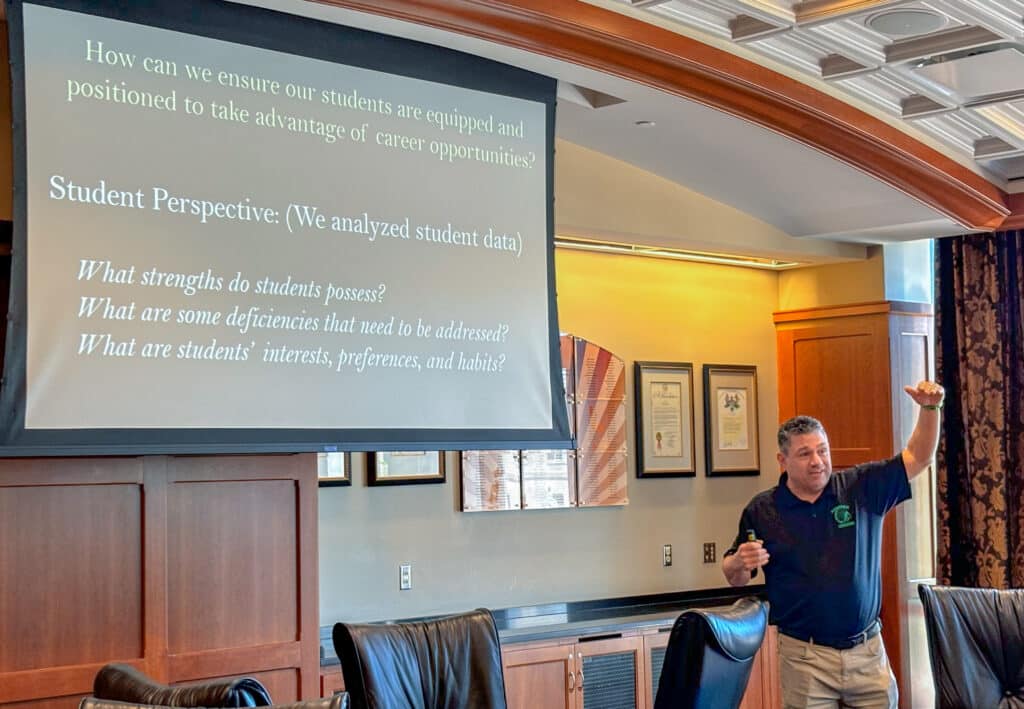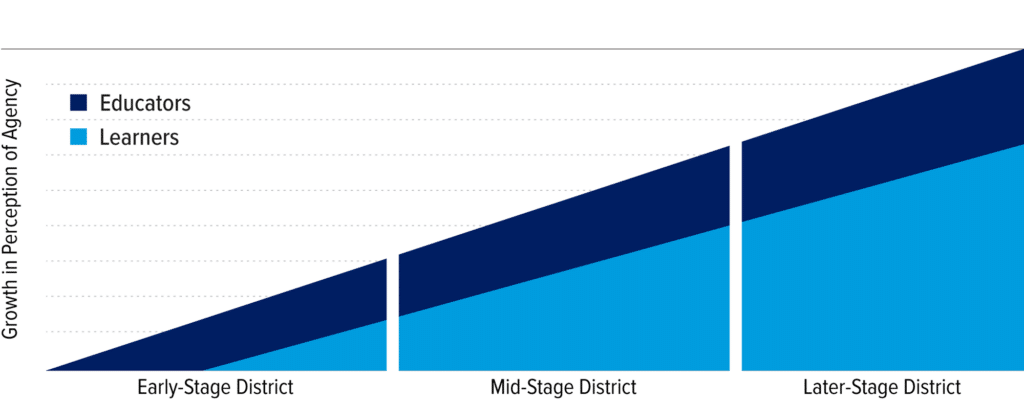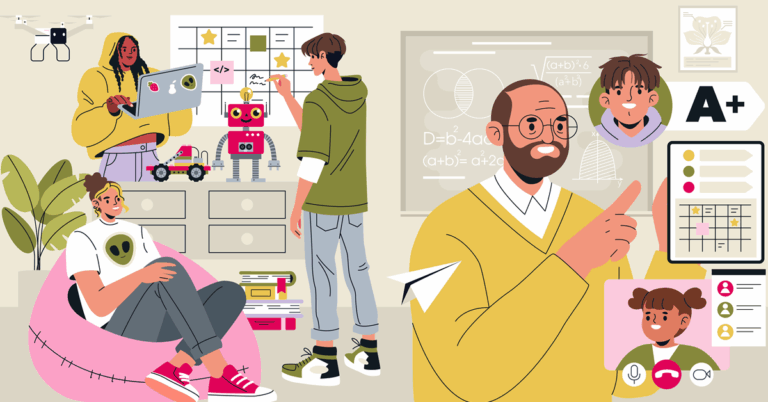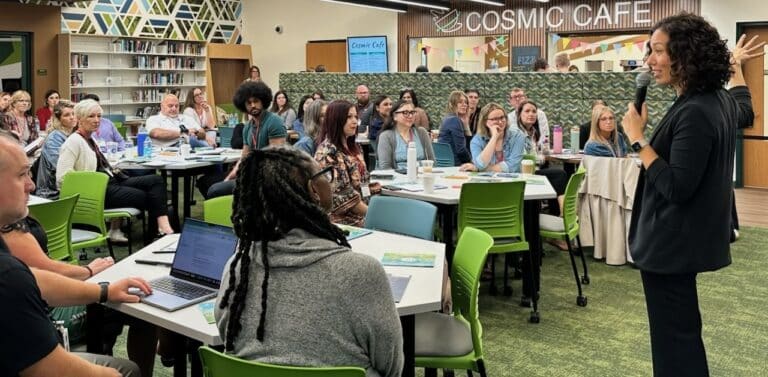Education outcomes and data are important, but they are most valuable when the research and dissemination are done in partnership with those closest to the work. That helps people involved in education systems change understand the impact of their work and also creates shared ownership of the outcomes.

Pete Dunn talks about how they use data to inform work in his session “Western BUILT: High School Reimagined” at the Ohio Personalized Learning Expo in June 2024. Western BUILT is a program from Western Local School District designed to create a pathway for our students to successfully transition from high school to career.
For KnowledgeWorks Vice President of Impact and Improvement Rebecca Wolfe, building the evidence base for the impact of personalized, competency-based learning must stay deeply connected to who we’re working with – and what motivates them.
“We want to center and highlight the very real experiences and hard work of our partners in districts, schools and learning communities,” said Wolfe. Just as we ask learning communities to include the people closest to the learning when making decisions, those most likely to be impacted by those decisions, we must do the same when exploring how best to study and communicate the impacts and outcomes of personalized, competency-based learning implementation.
That’s why when we thought about how best to share what we’re learning in our latest research, we did so in collaboration with our partners. Partners like Maria James, an elementary social studies specialist with Mesa Public Schools in Arizona, who experiences the joy of working with educators firsthand.
“It’s a bright spot for me to be able to get in the trenches with teachers and see their knowledge and their excitement and their joy of being in their classrooms come to life,” said James. Mesa Public Schools is one of a cohort of districts in Arizona that have partnered with KnowledgeWorks to shift to a more student-centered approach to teaching and learning. “The teachers are able to not only personalize for the students but personalize their own learning, as well.”
Arizona: Four Districts, Five Years
In 2019, the Center for the Future of Arizona developed the Arizona Personalized Learning Network, a cohort of four districts that made a five-year commitment to shift to a personalized learning approach: Amphitheater Public Schools, Mesa Public Schools, Santa Cruz Valley Unified School District No. 35 and Yuma Union High School District. District leaders in the Arizona Personalized Learning Network participate in planning, coaching and school implementation efforts and receive personalized support from the Center for the Future of Arizona and KnowledgeWorks. Here’s what it looks like in action.
While our research efforts are concerned with large-scale change, we balance data on major trends and outcomes with what’s happening in classrooms, between educators and learners.
“Personalized learning has actually allowed the scholars to find out their why – and their why not,” said Ruth Ray, M. Ed., STEAM integration coordinator PreK-12 with the Warrensville Heights City School District Department of Curriculum and Instruction in Warrensville, Ohio. “Putting them in this type of environment and allowing them to shine in their own space has been very rewarding.”
Ohio: Personalized Learning at Work
With support from the Ohio Department of Education and Workforce (formerly the Ohio Department of Education), Ohio Educational Service Centers, regional personalized learning specialists and KnowledgeWorks, the Ohio Personalized Learning Network launched in 2022 and connected educators, schools and districts to professional learning focused on helping local communities expand systems and approaches that center the individual needs of every learner. These five case studies highlight approaches to personalized learning in Ohio.
As we work with cohorts of schools and districts in Arizona, North Dakota, Ohio and South Carolina, we’ve been collecting and reflecting on data that provides a lens on the kinds of transformative systemic change we hope to see happening and sustaining. Large-scale change must be considered in two ways: breadth and depth. Breadth is the number of individuals involved across multiple systems of education and students, not isolated schools of innovation. Depth is a commitment to change structural and cultural norms of entrenched traditional systems, such as in a district or multiple districts in a cohort or state.
To benchmark change and measure the implications of large-scale, transformational change in education, we’re asking ourselves the same questions researchers in any field are asking:
- What happened?
- How did it happen?
- Can it happen elsewhere?
- What was the impact of what happened?
Through several recent research reports from our partners and our own From Theory to Practice: Cross-State Themes in Student-Centered Systems Change, we’ve been able to document much more about the breadth and depth in order to answer the first two questions. And we are closer than ever to being able to answer whether what we are observing can happen elsewhere. This research has begun to surface insights into the critical questions of impact, with more coming in the near future.
Themes That Emerge in Stages of Implementation
Early-Stage
Basic understanding, primarily held by leaders or small cadre of champions
Little to no
implementation
in practice
Schools or district participated in cohort
less than a year
Mid-Stage
Growing understanding,
held by more leaders
and champions
District implementation underway and in
pockets in schools
Schools or district participated in cohort under three years – or more than three years but with significant interruption
Later-Stage
Deeper understanding,
held by broad number
of leaders, champions
and community
District implementation continues and more consistent practices
across schools
Schools or district participated in cohort more than three years with no significant interruption

Our analysis revealed that in the early stage, far more educators (dark blue) are reporting a sense of agency and engagement than students. That group grows in the mid-stage and later stages more dramatically for students as at some point. This is the spread. But the depth of learner agency is slower to show up. Based on the evidence from later-stage districts, it will be much longer before students are meaningfully incorporated into decision-making about the pathways, policies or district plans. Source: From Theory to Practice: Cross-State Themes in Student-Centered Change. (KnowledgeWorks.)
Contextualizing the data we’ve found with testimonials and firsthand evidence from educators within our learning communities powerfully grounds what we’re learning.
“The hard, hard, hard work is happening at the local level,” said Ann Ellefson, director of academic support with the North Dakota Department of Public Instruction. “What we’ve found is that when a school doesn’t have a clear why, it takes quite a bit of time for this work to get off the ground. But when there’s something that resonates, whether it’s standards-based grading, community service projects, those real-life opportunities, the personalized structure allows for learning to go deeper and implementation to go faster.”
North Dakota: Six Years Later…
The North Dakota Network for Personalized Learning is supported by the North Dakota Department of Public Instruction, KnowledgeWorks and other partners. Participating school districts made a commitment in 2017 to personalized, competency-based learning through changes to both policy and instructional practice and are being assessed for impact. Districts in the study are Northern Cass Public Schools, Oakes Public Schools and West Fargo Public Schools. See how far they’ve come.
When implemented well, personalized, competency-based learning thrives on meaningful connections between the individuals doing this work. They understand why it matters, and that understanding increases their commitment to it. We see this in agency and engagement metrics. The longer our partners are engaged in the work of personalized, competency-based learning, the more agency we see for educators and learners. Agency and engagement are key levers for learning. Evidence for the growth of agency and engagement is also showing up in attendance levels too. We are seeing statistically significant higher rates of attendance in districts pursuing personalized, competency-based learning in North Dakota and South Carolina than comparisons.
South Carolina: From Possibilities to Realities
The South Carolina Department of Education established an Office of Personalized Learning (now the Personalized Learning Team) which created a state-level Framework for Personalized Learning to support all students in achieving the Profile of the South Carolina Graduate. The Personalized Learning Team and KnowledgeWorks are supporting schools and districts across the state in their implementation of personalized, competency-based learning; to date, schools in close to 90% of districts have engaged with the Personalized Learning Team since its inception six years ago. Peer-to-peer learning is a cornerstone of South Carolina’s approach.
“One of the things our superintendent charged us with was engagement,” said Ray. “Once we began to think about getting all our scholars engaged – and getting clear on why they are not engaged – we realized it was about bringing them into a trusting space. They’re being identified and talked to so we can hone into their talents and how they can learn best.”
Ray also stressed how making the connection between their work to personalize learning and the data has helped their efforts stick. “This is not just another thing we are doing. It’s something that’s having a direct impact on the data in our state report card that is driving our district to success,” said Ray.
Each data point we gather reflects a learner or an educator who is showing up to school in a new way, with clearer priorities, connections and understandings.
James brings it back to what drives so many to embrace education in the first place: the impact teaching and learning can have on the individual. Especially when that individual might otherwise have been left behind.
“This work speaks to me because of my own child,” said James. “Knowing that I saw him not fitting in but showing up willing, smart and capable every day, it was like he was trying to fit a square into a circle. He is now thriving in a school that embraces personalized learning. In another school, he would’ve been a statistic.”
This was written by former Senior Manager of Communications Jillian Kuhlmann.





